Induro GIT 304L Tripod
Out of production for more than two years, BAA has just one of my favorite-ever tripods left in stock. The 304L was my go-to tripod for more than a decade. Best to grab this last one here right now.
|
|
|
This all-new card includes images created on my JAN 2022 visit to San Diego. Click on the composite to enjoy a larger version. |
The 2022/23 San Diego Brown Pelicans (and more!) IPTs
San Diego IPT #2. 4 1/2 DAYS: SAT 7 JAN thru the morning session on WED 11 JAN 2023: $2699.00. Deposit: $699.00. Limit: 6 photographers/Openings: 2.
San Diego IPT #3: 4 1/2 DAYS: THURS 19 JAN thru the morning session on MON 23 JAN 2023: $2699.00. Deposit: $699.00. Limit: 6 photographers/Openings: 5.
Please e-mail for information on personalized pre- and post-IPT and In-the-Field Sessions.
Join me in San Diego to photograph the spectacular breeding plumage Brown Pelicans with their fire-engine red and olive green bill pouches; Brandt’s (nesting) and Double-crested Cormorants; breeding plumage Wood and Ring-necked Ducks; other duck species possible including Lesser Scaup, Redhead, Northern Shoveler and Surf Scoter; a variety of gulls including Western, California, and the gorgeous Heermann’s, all in full breeding plumage; shorebirds including Marbled Godwit, Willet, Sanderling and Black-bellied Plover; many others are possible including Least, Western, and Spotted Sandpiper, Whimbrel, Black and Ruddy Turnstone, Semipalmated Plover, and Surfbird; Harbor Seals and California Sea Lions (both depending on the current regulations and restrictions). And as you can see by studying the IPT cards, there are some nice bird-scape and landscape opportunities as well. Not to mention a ton of excellent flight photography opportunities and instruction.
Please note: where permitted and on occasion, ducks and gulls may be attracted (or re-located) with offerings of grains or healthy bread.
|
|
|
San Diego offers a wealth of very attractive natural history subjects, including and especially the Pacific race of California Brown Pelican. With annual visits spanning more than four decades, I have lots of photographic experience there … Click on the composite to enjoy a larger version. |
Learning Exposure, Whether You Like It Or Not
Whether you like it or not, we will be beating the subject of exposure like a dead horse. In every new situation, you will hear my thoughts on exposure along with my thoughts on both Nikon and Canon histograms and SONY Zebras. Whether you like it or not, you will learn to work in manual mode so that you can get the right exposure every time (as long as a bird gives you ten seconds with the light constant). Or two seconds with SONY zebras … And you will learn what to do when the light is changing constantly. What you learn about exposure will be one of the great takeaways on every IPT.
|
|
|
Though the pelicans will be the stars of the show on this IPT, there will be many other handsome and captivating subjects in wonderful settings. Click on the composite to enjoy a larger version. |
It Ain’t Just Pelicans
With gorgeous subjects just sitting there waiting to have their pictures taken, photographing the pelicans on the cliffs is about as easy as nature photography gets. With the winds from the east almost every morning there is usually some excellent flight photography as well, often with 70-200mm lenses! And the pelicans are almost always doing something interesting: preening, scratching, bill pouch cleaning, or squabbling. And then there are those crazy head throws that are thought to be a form of intra-flock communication. You will be guided as to how to make the best of those opportunities. Depending on the weather, the local conditions, and the tides, there are a variety of other fabulous photo chances available in and around San Diego.
|
Did I mention that there are lots of great birds and natural history subjects in San Diego in winter? Click on the composite to enjoy a larger version. |
The San Diego Details
These IPTs will include four or five 3-hour morning photo sessions, three or four 1 1/2-hour afternoon photo sessions, and three or four working brunches that will include image review and Photoshop sessions. On rare cloudy days, we may — at the leader’s discretion, stay out in the morning for a long session and skip that afternoon. To ensure early starts, breakfasts will be your responsibility. And so that we can get some sleep, dinners will be on your own as well. In the extremely unlikely event that Goldfish Point is closed due to local ordinance (or whimsy) — that has never happened in the past fifty years, I will of course do my very best to maximize our photographic opportunities.
|
|
|
San Diego offers a wealth of very attractive natural history subjects, including and especially the Pacific race of California Brown Pelican. With annual visits spanning more than four decades, I have lots of photographic experience there … Click on the composite to enjoy a larger version. |
Deposit Info
A $699 deposit is required to hold your slot for one of the 2022/23 San Diego IPTs. You can send a check (made out to “BIRDS AS ART”) to us here: BIRDS AS ART, PO Box 7245, Indian Lake Estates, FL, 33855, or call Jim or Jennifer at the office with a credit card at 863-692-0906. Your balance, payable only by check, is due three months before the trip.
|
Variety is surely the spice of life in San Diego. Click on the composite to enjoy a larger version. |
Getting Up Early and Staying Out Late
On all BIRDS AS ART IPTs, including and especially the San Diego IPT, we get into the field early to take advantage of unique and often spectacular lighting conditions and we stay out late to maximize the chances of killer light and glorious sunset silhouette situations. We often arrive at the cliffs a full hour before anyone else shows up to check out the landscape and seascape opportunities.
What’s Up?
Again, the dire weather forecast for this week failed to materialize. It rained most of the night and quit at about 6am. There was a strong NW wind so the cloudy skies were a blessing. I did high ISO flight, mostly with the tripod-mounted 600mm f/4. The incoming pelicans were parachuting down with their feet hanging below them as they floated down to land. As the wind dropped, I created many fine images of the male Anna’s Hummingbird — 70 keepers after the first edit! I used the tripod-mounted 600mm f/4 with the 1.4X TC. This bird has been quite reliable this year. I went to Hospitals for the sunset that showed promise but fizzled. I had some nice land/sea/wave-scapes lined up with the tripod-mounted Sony 70-200mm II lens. As I was shooting down from atop the cliff, the zillion tourists were somewhat of a problem.
Today is Thursday 29 December 2022. The forecast is for cloudy with a gentle SE breeze. I will be at the cliffs early. This blog post took about an hour to prepare and makes two hundred seventy-six days in a row with a new, educational post just for you. Wherever you are and whatever you are doing, I hope that you too have a great day.
Please remember to use the B&H and Amazon links that are found on most blog pages and to use the BIRDSASART discount code at checkout when purchasing your new gear from Bedfords to get 3% back on your credit card and enjoy free second-day air FedEx. Please, also, consider joining a BAA IPT. You will be amazed at how much you will learn!
You can find some great photo accessories (and necessities, like surf booties!) on Amazon by clicking on the Stuff tab on the orange/yellow menu bar above. On a related note, it would be extremely helpful if blog-folks who, like me, spend too much money on Amazon, would get in the habit of clicking on the Amazon logo link on the right side of each blog post when they shop online. As you might expect, doing so will not cost you a single penny, but would be appreciated tremendously by yours truly. And doing so, works seamlessly with your Amazon Prime account.
Please remember that if an item — a Delkin flash card, or a tripod head — for example, that is available from B&H and/or Bedfords, is also available in the BAA Online Store, it would be great, and greatly appreciated, if you would opt to purchase from us. We will match any price. Please remember also to use my B&H affiliate links or to earn 3% cash back at Bedfords by using the BIRDSASART discount code at checkout for your major gear purchases. Doing either often earns you free guides and/or discounts. And always earns my great appreciation.
|
|
|
Be sure to click on the image to view the larger, high res version. See me in the center of the pupil. Image #1: Pelican Eyeball Self-Portrait |
Pelican Eyeball Self-Portrait Courtesy of the Sony a1
And Excellent Long Lens/TC Sharpness Technique
Yes, that is my reflection in the center of the bird’s pupil, working off the tripod just beyond the fence. Pretty sharp, no?
There is a spot at La Jolla where, in certain weather conditions, you can get 15 feet from the pelicans without even trying. You can get a bit closer by putting one leg of the tripod over the fence — just do it slowly. To ensure accurate focus and sufficient depth of field where you need it, learn to use Focus Peaking. Most modern dSLRs and mirrorless bodies offer this feature. With Sony, I set Focus Peaking up so that the in focus overlay is red.
When working with long effective focal lengths and relatively slow shutter speeds, you need to employ your best long lens sharpness techniques. Join me on an IPT to learn exactly how.
The astounding image quality of the a1 speaks for itself in this huge crop of the image below. And the same might be said about my long lens sharpness techniques.
|
|
|
This, the original image for the eyeball crop above, was created on 27 December 2022 at La Jolla, CA. While standing at full height I used the no-longer available Induro GIT 304L tripod/Levered-Clamp FlexShooter Pro-mounted Sony FE 600mm f/4 GM OSS lens with the Sony FE 1.4x Teleconverter, and The One, the Sony Alpha 1 Mirrorless Digital Camera.. ISO 1000. Exposure was determined via Zebras with ISO on the rear dial: 1/60 sec. at f/9 (stopped down 1 1/3-stops). AWB at 3:50:15pm on a cloudy afternoon. Manual focus with Focus Peaking performed perfectly. Be sure to click on the image to enjoy the higher res version. Image #2: Brown Pelican (Pacific-race) 2-year old resting — face portrait |
Looking for Special & Executing the Plan
I walked by this resting young bird about six times while searching for a colorful adult. Each time I passed it, the pink eye-skin called out to me. Finally, I succumbed and went to work. I set up perfectly parallel to the face. I was lucky to have the out-of-focus feathers of the next young pelican as the brown background. Focus Peaking showed me that f/9 covered the face. Experience told me that I could make sharp images at 1/60 sec. at 840mm. And Zebras showed me that I needed ISO 1000 to create a perfect exposure in the low light. Vision plus technique paves the road to making successful images.
Typos
With all blog posts, feel free to e-mail or to leave a comment regarding any typos or errors.

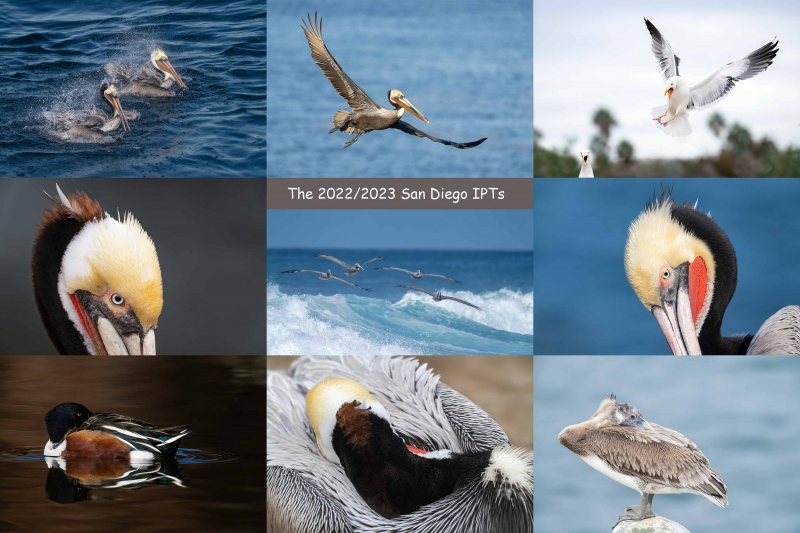
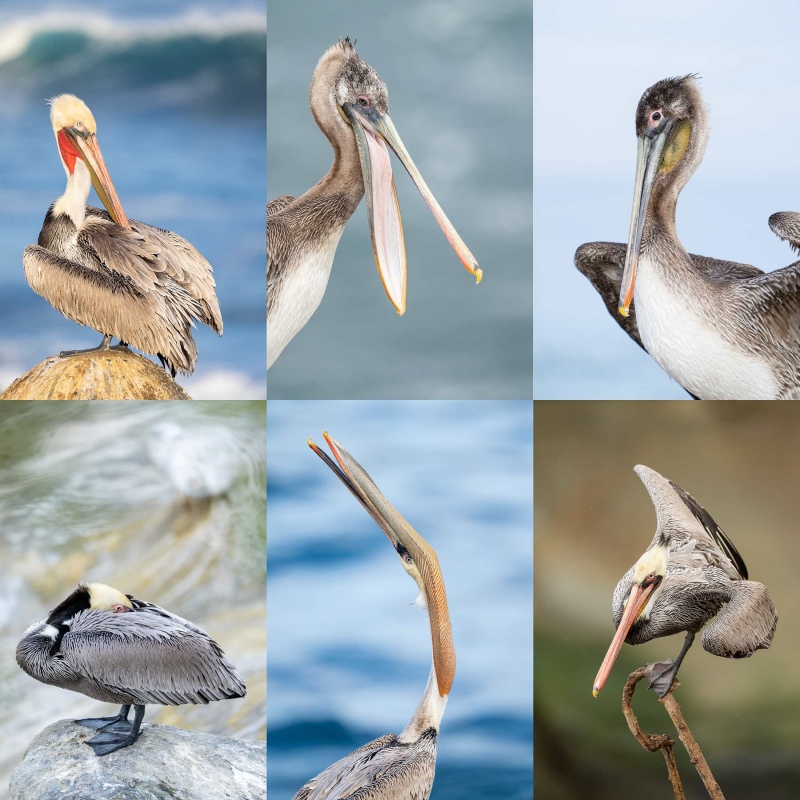
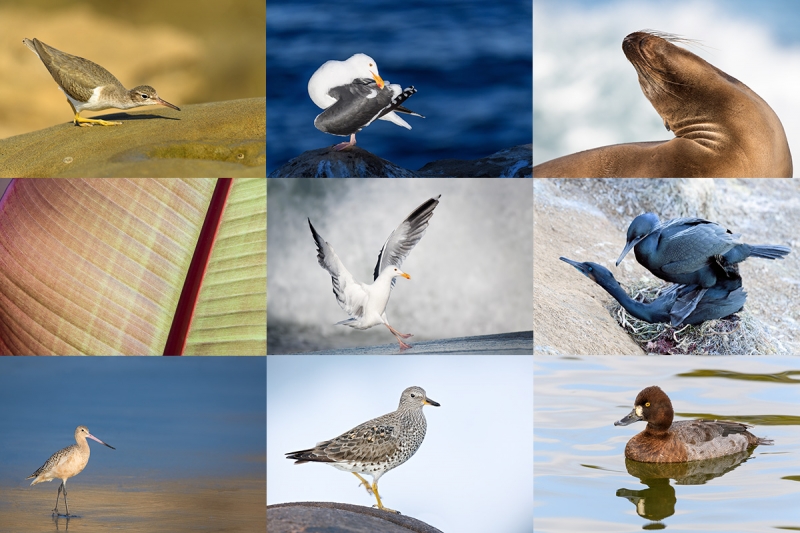

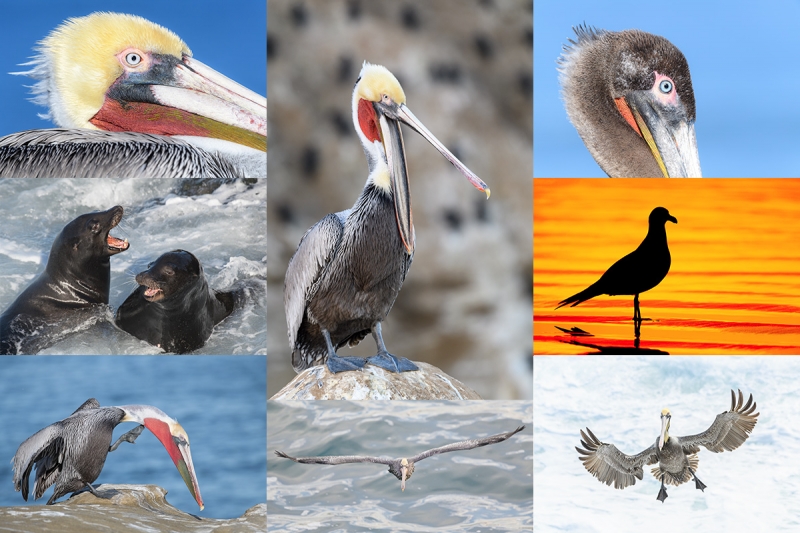

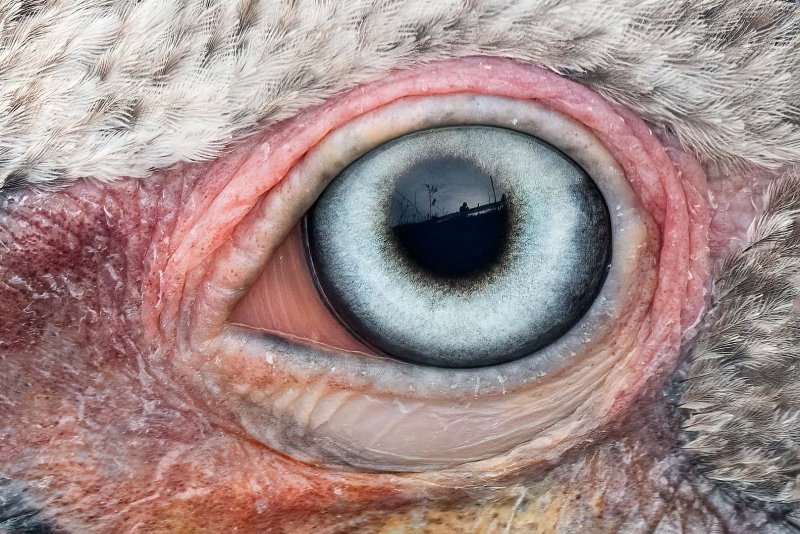
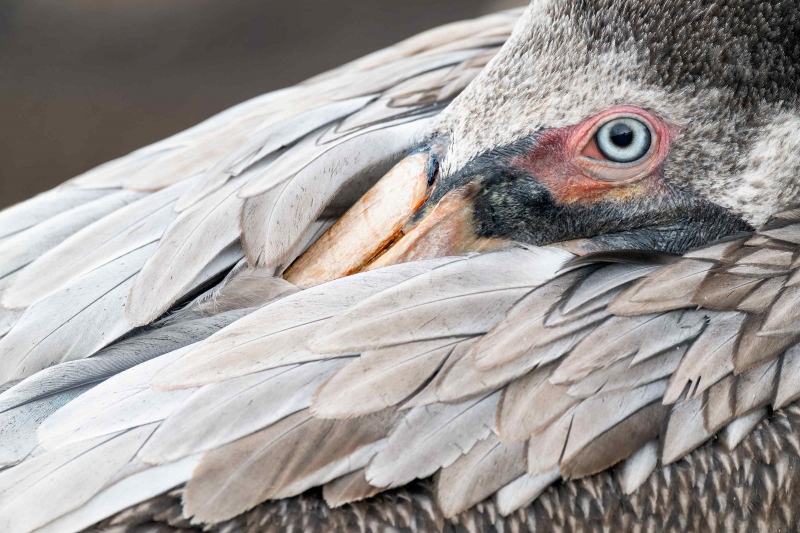













Image #1: Pelican Eyeball and Image #2: Brown Pelican are interesting!!
I think it’s “focus peaking,” not “focus peeking.” I’m not sure I understand it in any case. I have taken “selfies” in a raven’s eye and in a deer’s eye. Cool image.
Thanks, David,
I did spell it right two out of four times 🙂
with love, a